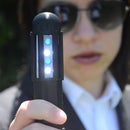Introduction: Zero-Gravity Grow-Cube
This project summarizes how to make a Grow-Cube that will grow plants in space.
I was very excited to start this project and had a lot of concept ideas floating in my head. To organize my ideas, I developed a list of requirements that the build had to meet. I also determined what my constraints were.
Overall, I wanted my grow-cube to be like the amazon rainforest: humid and warm. In this project, I was constrained by a 14 year old's budget. So I had to be creative in purchasing absolutely necessary components from amazon and recycled materials (thrift store searches and "borrowing" parts from my parents). The final cost for this project was under $75, so it was easy to create with a minimal allowance. This is an entry for the High School Category.
Supplies
- 4'x8'x1" sheet of Styrofoam with reflective coating
- 55 hydroponic grow nets
- 1 roll of window flashing tape
- 2 scrap hinges
- 8 1-inch nuts and bolts
- A mini refillable humidifier (battery powered)
- A hairdryer (thrifted for $4!)
- 2 1/2 feet of scrap 1" diameter PVC
- 12v battery (borrowed from my dad's motorcycle)
- Silicone
- a Terminal Strip
- Fan
- Mesh
- Rubber Bands
- 2 screws
- Hydroponic growing solution
Tools:
- Drill with circular drill bits (2" and 1")
- Miter saw
- Measuring tape
- L-square ruler
- Utility knife
- Pull saw
- Marker
- Soldering Iron and Soldering Metal
- Scissors
- Screwdriver
Step 1: Design
For the grow cube, I knew it had to meet the following three requirements listed on the contest page:
1. The dimensions had to be a 50 cm cube
2. It had to contain all necessary features for growth
3. It needed to use available space in an inventive and effective manner
I wanted the box to be like the Amazonian rainforest:
- Humid, warm, strong light source, movement of air
Overall, the project had to be cheap, lightweight, and use materials that were easy for a high-schooler to acquire.
In my grow-cube, I incorporated all of these ideas while maximizing space.
I wanted to reduce the overall risk for my project, so I used inexpensive materials. This was a concept idea, so I didn't want to waste money and materials if the idea didn't go as planned.
At first, I wanted to make 2 shelves in the box, and have tubing go under each shelf and connect to the planters. However, I also wanted to take advantage of the zero gravity on the ISS, so I designed the box to have planters on all 6 sides of the cube to utilize every wall. When the plants grow towards the center, they maximize the growing space.
This means that the total growing space is around 15,000 cm^2, which is 10,000 more cm^2 than my previous shelving idea which only had 5000 cm of growing space.
Step 2: Cut the Foam to Size
First, I needed to cut the foam so it formed an exact 50cm^3 box. I accounted for the width of the foam, which was 1 inch. This means that some pieces have to be 1 inch shorter on some sides.
The dimensions were:
Top and Bottom: 50 cm x 50 cm
Left and Right sides: (50 cm - 2 inch) x 50 cm
Front and Back sides: (50 cm - 2 inch) x (50 cm - 2 inch)
After marking these dimensions using a L-square and marker, I cut the pieces using an utility knife and a pull saw.
I used this type of Styrofoam because it was cheap, at around $15 for the entire board. It is also insulative, and has reflective material on one side, and is waterproof as well.
Step 3: Marking and Drilling the Holes
Next, I marked and drilled holes for the plant baskets. These holes needed to be small enough so the basket didn't fall right through. I used a 2" circular drill bit. I decided that nine baskets per wall would give each plant the right amount of space to grow and thrive. I drew a 4x4 grid using an L-Square and marker. Then, I drilled a hole in each intersection point. Use an extra piece of foam for drilling on, else you might ruin your flooring (not speaking from experience, thankfully)! This is also a messy process, because small pieces of foam will get everywhere. So make sure you have a vacuum or broom handy.
Step 4: Adding the Plant Baskets
After drilling the holes, the foam is ready for the plant baskets. You will not need to put baskets in the center hole of the top and bottom pieces, because that is where the lighting will go. To secure the baskets in place, put squares of aluminum tape on the backside of each hole. This should be the side with the non-reflective material. After you finish this, cover the bottom of the pot with silicone for a sturdy fit. Then simply push the basket into the hole.
I laid all the pieces out, and labeled them as right, left, top, bottom, etc. so I wouldn't get confused assembling them later.
Step 5: Lighting
For the lighting, I chose to use purple grow lights because, in short, red and blue LEDs are the best suited for plant development, and to help the process of photosynthesis. I bought these particular strip lights from Amazon, because they can be cut to whatever size you want, and they are adhesive and waterproof. To make the light "wand", or as I like to call it, the grow-saber, cut a piece of PVC to 55 cm and tightly wrap the LEDS around it. For added security, use zip-ties to secure both ends. This LED strip is powered by a 12v adapter, and can be plugged into an outlet.
Step 6: Watering Systems
Designing a watering system was challenging for me. At first, I wanted to use a peristaltic pump to pump water through tubing to each and every one of the plants. But since I wanted the grow-cube to function like the rainforest (warm, humid), I looked for a different way to water the plants. One way was through a humidifier, which would water plants through a process called osmosis. When the humidifier releases water, or moisture into the air, it would spread throughout the chamber, and provide enough water for the plants.
The first version of the humidifier was a mushroom humidifier attached with rubber bands to a work glove filled with water. Needless to say, this caused a huge mess when it started leaking. The next version was the same humidifier, but with a sandwich bag. This was secured with rubber bands and duck tape. I also constructed a small shelf that would sit in the corner of the box and contain the bag and humidifier (pictured above). The shelf was 4" x 4", relatively small. Unfortunately, this system also leaked.
The final rendition used a different mushroom humidifier, which came with a water container. This is completely waterproof, and also serves as a handle for the door. The container is filled with a water and hydroponic nutrient mixture.
Step 7: Construction of the Box
To build the main box, I used silicone and aluminum tape. I squeezed a line of silicone on the base, and glued the right wall on first, and secured it with a strip of aluminum tape. Following this, I repeated the process with the front and back walls. Before securing the top, place the lighting PVC in the hole in the bottom of the base. When you put the top piece of foam on, it secures the PVC in place. Then, I assembled the door from the left wall. I screwed on the two hinges using the nuts, bolts and washers. The head of the screw with a washer goes on the side of the foam opposite of the hinge.
After this, I installed my prototype watering shelf with aluminum tape, but I removed it after I received the humidifier with the bottle attached.
Step 8: Heat and Air Systems
The next crucial element in a rainforest is heat. Therefore, I needed a system that heated and blew air around the chamber. To do this, I bought a hairdryer from Goodwill for only $4, and disassembled it. I wrapped the heating coils from the dryer around a 6" piece of 1" PVC. For the fan, I used the one from the hairdryer.
I used the 12v battery, and made a parallel circuit with the hair dryer and the fan so they each got equal amounts of power. I also used a terminal strip to connect the battery and the components. The positive wire goes from the battery to a switch, which then connects to the terminal strip, which is connected to the fan and heater. The negative wire runs back from these pieces to the terminal strip, and back to the battery to complete the circuit.
To secure these pieces in the box, I zip-tied the fan to the lighting PVC, and used some extra PVC to compression fit the heater. One improvement to this would be to make the PVC for the heater 53 cm, so it was just one piece.
Then, I ran the wiring out the back of the box, and screwed the terminal strip to the back of the box.
Step 9: Grow Pellets and Plants
In order to activate the grow pellets, they needed to be soaked in water. After they fully expanded, I put them in the plant holders. For the baskets on top, I used some mesh from an onion bag. I cut the mesh so it was bigger than the top of the basket, and secured it with a thin rubber band that did not apply too much pressure. Then, I cut a hole in the center of the mesh, so that only the plant could get out, and not the dirt pellet. Because of gravity, all the other pellets stayed in place, but in space, I would use the mesh so none of them float around.
For the test plants, I used some green onion. When I planted them in the baskets, they all stayed in, so I deemed the grow-box effective and innovative!
Step 10: Reflection
Improvements:
There are a few aspects of this project that I could improve in later versions. For this version, I had a limited budget, so I only used inexpensive supplies. In the next version, I could use aluminum for the walls, and spend more money to make the final product stronger and able to withhold space flight. I would cover all of the baskets with mesh to secure them. Also, I might include another watering system with tubing, and the humidifier to provide adequate water and humidity for plants.
What I liked about the final product:
I liked how light this product was. It only weighed around 7.8 lbs! I also liked how this grow-cube took advantage of all 6 walls and zero-gravity.
From this experience, I learned more about the design process and prototyping, and now have a greater respect for the efforts that go into growing plants at NASA.

Participated in the
Growing Beyond Earth Maker Contest











